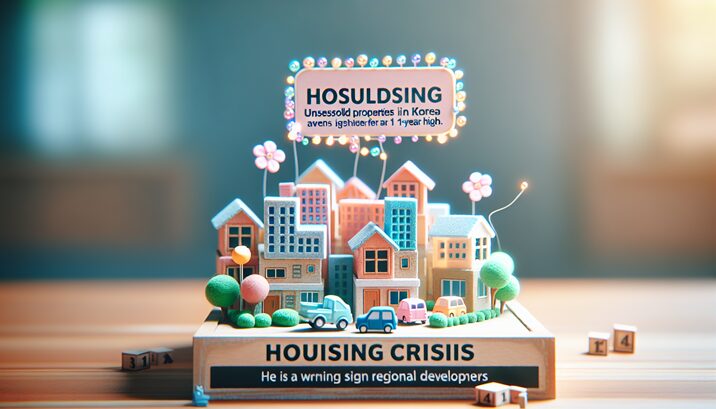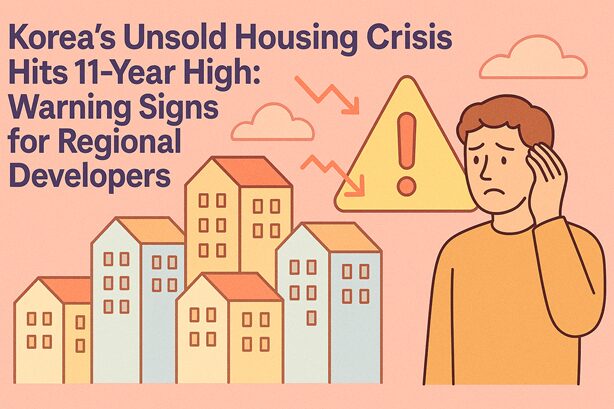Korea’s Unsold Housing Crisis Hits 11-Year High: Warning Signs for Regional Developers
The Korean housing market is flashing serious warning signals as unsold housing inventory reaches levels not seen in over a decade. Newly completed but unsold housing units have doubled year-over-year, with regional markets bearing the brunt of this troubling trend. With construction companies increasingly filing for bankruptcy protection, could this be the canary in the coal mine for Korea’s broader property market?
Record-Breaking Inventory Levels
The number of unsold homes has surged to an 11-year high, pointing to a significant imbalance in Korea’s regional housing markets.
- As of February 2025, Korea reported 23,722 completed but unsold housing units nationwide
- This represents a staggering 99.9% increase compared to the same period last year
- The current inventory level marks the highest recorded figure in 11 years and 5 months
Regional Markets Hit Hardest
The housing crisis is disproportionately impacting areas outside the capital region, creating a two-tier market dynamic.
- A striking 80.8% (19,179 units) of all unsold inventory is concentrated in regional markets
- Daegu leads with 3,067 unsold units, representing 12.9% of the national total
- Other severely affected regions include North Gyeongsang (2,502 units), South Gyeongsang (2,459 units), South Jeolla (2,401 units), and Busan (2,261 units)
- Ulsan has experienced the most dramatic deterioration, with unsold inventory skyrocketing by 312.9%

Government Intervention Falling Short
Official measures to address the crisis may prove insufficient given the scale and structural nature of the problem.
- The Korea Land & Housing Corporation (LH) has pledged to purchase approximately 3,000 unsold units
- Additional support includes preferential interest rates through the “Stepping Stone” loan program
- Industry experts describe these interventions as mere “CPR” rather than addressing fundamental market weaknesses
- Political uncertainty is further extending the market downturn, complicating recovery efforts
Liquidity Crisis Threatening Construction Sector
Financial distress is spreading through the construction industry as companies struggle with cash flow issues from unsold inventory.
- Several regional construction companies have filed for court receivership in recent months
- The inability to recover invested capital is creating severe liquidity challenges
- This threatens a potential domino effect through the construction supply chain
- Industry analysts warn that smaller and mid-sized developers are particularly vulnerable to insolvency

The rapidly deteriorating housing market outside Seoul represents a critical juncture for Korea’s property sector and regional economies. While government intervention provides some support, the question remains whether these measures can stem the tide or if more fundamental structural reforms are needed to address the growing imbalance between supply and demand in regional housing markets.
Keywords
Korea housing market, unsold housing inventory, construction bankruptcy, regional property market, government intervention
Hashtags
#KoreaHousingCrisis #PropertyMarket #RegionalDevelopment #ConstructionIndustry #RealEstateDownturn
한국어 요약
- 2025년 2월 기준, 준공 후 미분양 주택이 23,722가구로 11년 5개월 만에 최대치 기록, 전년 동기 대비 99.9% 증가
- 전체 미분양의 80.8%(19,179가구)가 지방에 집중되어 있으며, 대구(3,067가구), 경북(2,502가구), 경남(2,459가구) 순으로 많음
- 정부는 LH를 통해 약 3,000가구 매입 및 디딤돌 대출 우대금리 지원 중이나, 전문가들은 근본적 해결책이 아니라는 평가
- 미분양으로 인한 자금회수 지연으로 지방 건설사들의 기업회생 신청이 증가하고 있어 건설업계 유동성 위기 우려 확산






